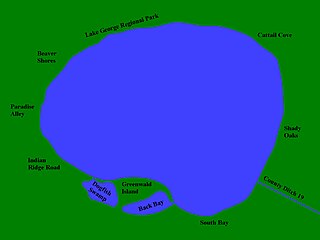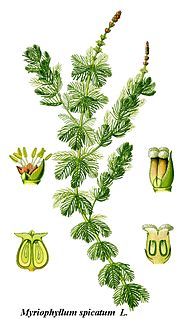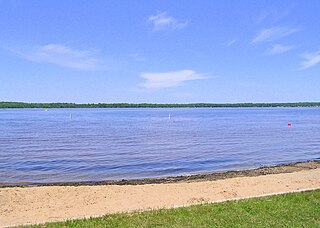
Aquatic plants are plants that have adapted to living in aquatic environments. They are also referred to as hydrophytes or macrophytes to distinguish them from algae and other microphytes. A macrophyte is a plant that grows in or near water and is either emergent, submergent, or floating. In lakes and rivers macrophytes provide cover for fish, substrate for aquatic invertebrates, produce oxygen, and act as food for some fish and wildlife.

Leech Lake is a lake located in north central Minnesota, United States. It is southeast of Bemidji, located mainly within the Leech Lake Indian Reservation, and completely within the Chippewa National Forest. It is used as a reservoir. The lake is the third largest in Minnesota, covering 102,947.83 acres (416.6151 km2) with 195 miles (314 km) of shoreline and has a maximum depth of 156 feet (48 m).

Potamogeton is a genus of aquatic, mostly freshwater, plants of the family Potamogetonaceae. Most are known by the common name pondweed, although many unrelated plants may be called pondweed, such as Canadian pondweed. The genus name means "river neighbor", originating from the Greek potamos (river) and geiton (neighbor).

Lake George is a small lake in Anoka County, Minnesota, located within the city of Oak Grove, 12 miles (19 km) north of the city of Anoka. Minnesota's Department of Natural Resources tracks the lake by the name George and the identifier 02-0091-00. The USGS tracks the lake by the ID 644081 and the coordinates of 45°21′25″N93°20′10″W

Myriophyllum spicatum is native to Europe, Asia, and north Africa, but has a wide geographic and climatic distribution among some 57 countries, extending from northern Canada to South Africa. It is a submerged aquatic plant, grows in still or slow-moving water, and is considered to be a highly invasive species.

Potamogeton crispus, the curled pondweed or curly-leaf pondweed, is a species of aquatic plant (hydrophyte) native to Eurasia but an introduced species and often a noxious weed in North America.

Lake Noquebay is a large freshwater lake in northeastern Wisconsin. It is the largest lake in Marinette county. It is located north of Green Bay, Wisconsin, approximately 4 miles (6.4 km) northeast of Crivitz, Wisconsin.
Mycoleptodiscus terrestris is a fungal plant pathogen.

Potamogeton natans, commonly known as broad-leaved pondweed, floating pondweed, or floating-leaf pondweed, is an aquatic species in the genus Potamogeton native to quiet or slow-flowing freshwater habitats throughout the Holarctic Kingdom.

Potamogeton perfoliatus is a perennial aquatic plant in the family Potamogetonaceae occurring in both standing and flowing freshwater habitats. It is widely distributed globally, occurring in all continents except South America and Antarctica.

Acentria is a monotypic moth genus of the family Crambidae described by James Francis Stephens in 1829. Its only species, Acentria ephemerella, the watermilfoil moth or water veneer, was described by Michael Denis and Ignaz Schiffermüller in 1775. It is used as an agent of biological pest control against the noxious aquatic plant known as Eurasian watermilfoil.

Myriophyllum verticillatum, the whorl-leaf watermilfoil or whorled water-milfoil, is a native to much of North America, North Africa, and Eurasia. It closely resembles another native milfoil, called northern water milfoil Whorled water milfoil is also easily confused with four types of invasive milfoils: Eurasian water milfoil, Variable water-milfoil, Parrot feather, and hybrid water milfoil.

Potamogeton diversifolius is a species of aquatic plant known by the common names waterthread pondweed and diverse-leaved pondweed. It is native to most of the United States, as well as sections of southwestern Canada, and northern Mexico, where it grows in water bodies such as ponds, lakes, ditches, and slow-moving streams. This is a perennial herb producing a very narrow, compressed stem branching to a maximum length around 35 centimeters. It has thin, pointed linear leaves a few centimeters long spirally arranged about the thin stem. The inflorescence is a small spike of flowers emerging from the water surface. Inflorescences also grow on submersed sections of the stem; these are smaller and spherical. It can be difficult to distinguish from similar species of pondweed.

Potamogeton epihydrus is a perennial aquatic plant known by the common names ribbonleaf pondweed and Nuttall's pondweed, and American pondweed in the United Kingdom. It is native to much of North America, where it grows in water bodies such as ponds, lakes, ditches, and slow-moving streams.

Potamogeton compressus is a species of aquatic plant known by the common names grass-wrack pondweed, flatstem pondweed and eel-grass pondweed.

Lake Winola is a public, 185 acres (0.75 km2) glacial lake in Overfield Township, Wyoming County, Pennsylvania, United States. The lake is composed of an eastern and western basin, separated by a peninsula entering the lake from north to south. The lake is managed by the Pennsylvania Fish and Boat Commission and operates a public boat launch located along the southeast corner of the lake. Motorized boats are permitted on the Lake, but are required to navigate counter-clockwise. The Scranton Canoe Club is located on Point Road (peninsula) offering club members a nine-hole golf course and lakeside dining.

The Mukwonago River is one of the cleanest and most biologically diverse streams in southeastern Wisconsin. The river is part of the Mukwonago River Watershed which spans 47,500 acres through and around the town of Mukwonago.

Lake Namakagon is located in Bayfield County, Wisconsin. The lake is a large freshwater drainage lake that opens inlet and outlet of streams located between Lake Superior and Mississippi River system. The lake is located in the upper Namekagon river watershed as St. Croix river basin is the subwatershed of it. The lake derives its name from the Ojibwe language, and it means "Lake abundant with sturgeons." It is known for tourism and as the home of the legendary Anishinaabe Chief Namakagon.
The Swan Lake Wildlife Area is a 2,466 acres (998 ha) tract of protected land located in Columbia County, Wisconsin, managed by the Wisconsin Department of Natural Resources (WDNR). Land to be used for the Wildlife Area was first acquired in 1963 to provide for hunting and other outdoor recreational activities in the county. In addition to outdoor recreation activities, the Wildlife Area was established to protect the Fox River watershed.